OR/17/003 Geological model
| Terrington, R, Thorpe, S and Jirner, E. 2017. Enköping Esker pilot study - workflow for data integration and publishing of 3D geological outputs. British Geological Survey Internal Report, OR/17/003. |
The model input files used to create the geological model for Enköping have been described in Data. The file formats are described in Table 3. The Generalised Vertical Section (GVS) defines the lithostratigraphic structure of the 3D geological model and its geological and geotechnical descriptions. The index level and downhole geological data files (.bid and .blg files respectively) were derived from the borehole information provided by SGU. All borehole coordinates were in SWEREF 99TM.
| Format (resolution) | |
| DTM | ASCII (5 m cell size) grid |
| Quaternary Geology Map | ESRI shapefile |
| Generalised Vertical Section (GVS) | SubsurfaceViewer/GSI3D ASCII text file |
| Borehole Index | SubsurfaceViewer/GSI3D ASCII (.bid) text file |
| Downhole Geology | SubsurfaceViewer/GSI3D ASCII (.blg) text file |
| Legend | SubsurfaceViewer/GSI3D ASCII (.gleg) text file |
| Georadar (GPR) | Image file (backdrops in cross-section) |
| Seismic Sections | Image file (backdrops in cross-section) |
| Project file | SubsurfaceViewer/GSI3D XML/ASCII (.gsipr) text file to store cross-sections and unit boundaries |
The format of the downhole geology file was prepared with the following structure (Table 4):
| HOLE ID | Depth to Base | LITHOLOGY | MAIN LITH | Borehole Source |
| 113300187 | 42 | GRUS | GRUS | Wells |
| 117100006 | 5 | PINNMO | PINNMO | Wells |
| 117100006 | 81 | GRANIT | GRANIT | Wells |
| 117100007 | 6 | PINNMO | PINNMO | Wells |
| 117100007 | 27 | GRANIT | GRANIT | Wells |
| RSG2002120602 | 12 | MELLANSAND | SAND | SGU |
| RSG2002120602 | 13 | MELLANSAND | SAND | SGU |
| RSG2002120602 | 16 | MELLANSAND | SAND | SGU |
| RSG2002120602 | 18 | MELLANSAND | SAND | SGU |
| RSG2002120602 | 19 | GROVSAND | SAND | SGU |
| RSG2002120602 | 20 | GROVSAND | SAND | SGU |
| STJ512855 | 10 | LERA-SILT (KOHESIONSJORD) | LERA | Boreholes |
| STJ512869 | 8 | LERA-SILT (KOHESIONSJORD) | LERA | Boreholes |
| STJ512919 | 35 | SAND-BLOCK (FRIKTIONSJORD) | BOULDERS | Boreholes |
| STJ512920 | 7 | LERA-SILT (KOHESIONSJORD) | LERA | Boreholes |
| STJ512921 | 16 | LERA-SILT (KOHESIONSJORD) | LERA | Boreholes |
| STJ512927 | 10 | LERA-SILT (KOHESIONSJORD) | LERA | Boreholes |
A total of 477 boreholes were provided by SGU for the construction of the geological model for Enköping. All of these boreholes were considered in the modelling. The orientation of cross-sections was defined by the selection of boreholes by the modeller after manual inspection of each borehole using the borehole viewer function of the SubsurfaceViewer. The best available boreholes were selected for inclusion in the geological model based on a subjective assessment of depth of drilling and quality of description. Each selected borehole was progressively added to the 2D cross-section window to construct a cross-section. 210 or 44% of the total boreholes were added directly to cross-sections in Enköping.
Cross-section construction
Cross-sections displaying downhole borehole information were displayed in turn, in the 2D cross-section window of SubsurfaceViewer. A preliminary assessment of downhole borehole records was used to group similar lithological units together. Where possible, each unit was grouped into the lithostratigraphic framework which came in-part from the Uppsala geological model constructed in 2015–2016 (Jirner et al, 2016[1]). Geological correlation lines, representing the base of each unit, were digitised by the modeller between boreholes corresponding to lithological units proved within them. Each correlated line was given a unique geological code. Geological units were correlated based on their order of superposition and relative age. This order defines which geological deposits can occur stratigraphically above or below others and is stored in the Generalised Vertical Section (GVS) file.
Importantly, each correlation line, corresponding to the base of a lithological unit is made up of a series of nodes digitised by the modeller. Each node stores a location and elevation unique to each geological unit. When all of the cross-sections are combined, the lines and nodes for every geological unit provide the basis for the calculation of the model. This method of on-screen digitisation, using boreholes and digital geological map data to constrain the surface and sub-surface distribution and geometry of the geological units, allows a detailed 3D conceptual model of the area to be developed.
The SubsurfaceViewer methodology provides the flexibility to incorporate the geoscientist’s interpretation where borehole or other data may be sparse or not available. For example, where borehole density is low or where boreholes do not penetrate geological rockhead, the modeller can enhance the 3D model, by using surrounding borehole data or locally derived knowledge, to define the thickness or geometry of the geological unit. The resulting 3D model therefore does not rely on borehole data alone.
Consistency between correlation lines on individual cross-sections is maintained by using functionality in SubsurfaceViewer to display equivalent correlations in intersecting cross-sections. These intersections are shown by a colour coded arrow and provide a visual check of intersecting geological units on each cross-section.
To ensure that all intersections with cross-sections, and subcrop and outcrop lines were snapped the project was exported to Groundhog Desktop.
A total of 43 cross-sections were correlated across the area of interest covering a total length of 292 km (Figure 17).
Envelope construction
The Quaternary geological map data were used to aid correlation and provide an initial assessment of the surface distribution of the superficial deposits.
Information derived from the distribution of nodes from geological correlation lines, representing the base of each unit, on cross-sections provided spatial evidence for the surface and subsurface distribution of each geological unit. Functionality in the SubsurfaceViewer and GSI3D™ enables all correlation lines and the points on them, to be identified and displayed in 2D plan view. The distribution of points displayed in 2D plan view, was then used to evaluate and constrain the surface and subsurface distribution of each geological unit. Envelopes defining the boundaries representing the combined surface and subsurface distribution of each geological unit were then constructed. Figure 18 shows the geological unit distribution sequence from the upper most unit to the lowest superficial unit.
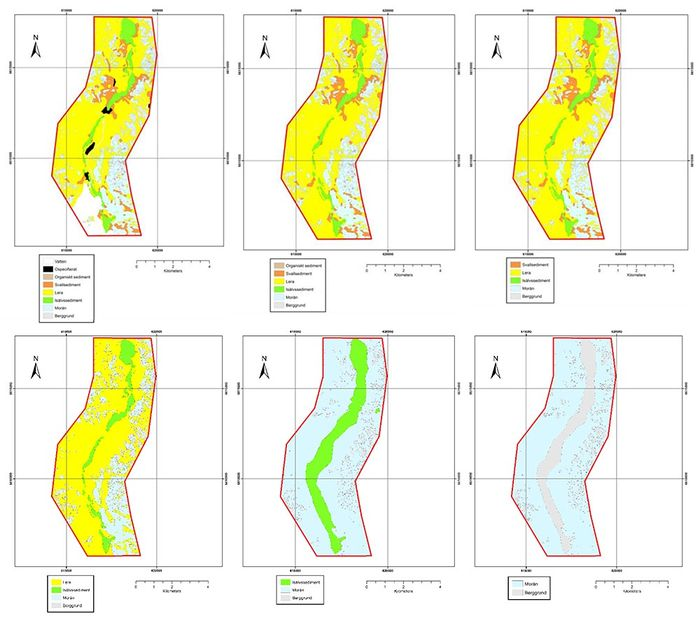
Model calculation
The 3D geological model was calculated by combining the correlated units present on cross- sections with the envelopes defining the distribution of those units. The modelling calculation in SubsurfaceViewer uses a proprietary Triangular Irregular Network (TIN) algorithm to create a series of surfaces representing the top and base of each geological unit from the individual nodes along correlation lines. The model is calculated ‘top-down’; beginning at the ground surface at the DTM and working downwards from younger to older geological units. This stack of surfaces forms the geological model from which the top and base elevation and thickness of every geological unit is calculated and exported.
The elevation and thickness of geological units at outcrop are determined from values derived from the DTM.
The SubsurfaceViewer has an additional function compared to GSI3D where the minimum thickness can be specified to ensure all units have some thickness applied. This circumvents a known issue when only using a direct triangulation of the points which can lead to spurious triangles occurring at or above the DTM or cause units to cross each other. An example of this can be seen in Figure 19 showing a synthetic cross-section from a model calculation with no minimum thickness applied using GSI3D. Figure 20 shows a cross-section calculation with a 1 m minimum thickness applied using the Subsurface Viewer. This forces surfaces to maintain a thickness of at least 1 m from the DTM using the order prescribed in the GVS.
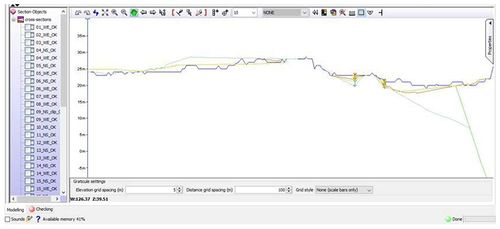
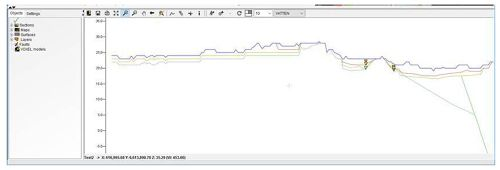
Grid export parameters
Below are the parameters that were used for the output of the ASCII grids (Top, Base and Thickness) for each unit in the geological model. An example of this output can be seen in ASCII grid output. The base ASCII grids produced were used in the Web Viewer output (see Web viewer).
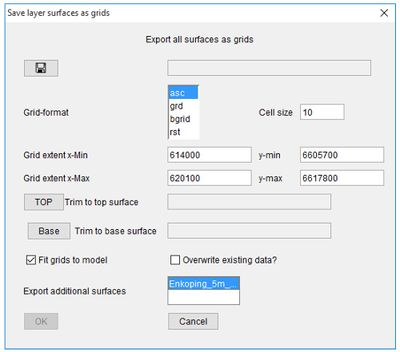
Quality assurance
Creating a 3D geological model in SubsurfaceViewer is an iterative process. The 3D model was verified for geological accuracy and consistency with the outputs of the related geological mapping programme in two main phases. The first phase of model verification was undertaken by the modelling team in consultation with Ricky Terrington and Steve Thorpe using the BGS in-house QA procedure (see Appendix 1 for QA worksheet). Cross-sections were assessed for geological consistency and a subset of boreholes were examined prior to the modelling phase to ensure the stratigraphy recorded was consistent with descriptions found in logs.
The second phase of model geological verification was carried out following modification of the model on the basis of this first phase of model assessment and review. This involved looking at the thickness of the deposits against the expected distribution of that unit (the total outcrop and subcrop combined). To increase the accuracy of model calculation, additional cross-sections were constructed around the perimeter of the project area and ‘helper’ infill sections were used to constrain units that had little or no borehole or cross-section data to constrain their thickness.
Limitations of the geological modelling
The SubsurfaceViewer is similar to the GSI3D approach for constructing geological models. They both are explicit modelling methodologies. This methodology has been the established approach for modelling Quaternary and simple bedrock horizons at the British Geological Survey for the past 15 years (Kessler et al, 2009[2]). Cross-sections are correlated between physical data such as boreholes, seismic data, topographical features and constrained by geological maps where available. Cross-sections can also be drawn where little physical data exists instead using qualitative reasoning and knowledge to apply thickness and geometry to the stratigraphy.
Therefore, surface horizons and volumes will have the greatest constraint close to cross-sections controlled by the physical data and be less constrained where cross-section correlations have been inferred by the geologist with little physical data control. In general, areas with little physical data and cross-section control will be the least constrained and therefore the least certain.
The location of cross-sections will impact on the calculated surface and thickness of each geological horizon. GSI3D uses Triangulated Irregular Networks (TIN) to interpolate between the X, Y and Z co-ordinates of every node drawn in cross-section combined with the ‘envelope’ which is the outcrop, sub-crop or a combination of both for each geological horizon. By using this interpolation method, the contours and isopachs generated will be less constrained further away from cross-sections and may generate spurious results particularly for thinner geological horizons where the topology or included surfaces such as in the DTM or the bathymetry vary significantly in elevation.
Model checks
The BGS have developed a standardised methodology for checking 3D models, which involves a series of 3 checking stages. The only check completed on the Enköping Esker model was a ‘technical check’. This process reviews the model for internal consistency by checking that all cross-sections match with the distribution described in 2D (outcrop and subcrop), that all croplines are snapped to either the DTM or a subcrop position, and that all cross-sections snap to each other. This checking process also follows a series of questions that dig into the modelling process, the data used, and the standards followed when modelling to ensure consistency. These questions can be found in the Appendix.
Much of the work was to ensure that the envelopes showing the full outcrop and subcrop of each unit matched the cross-sections. In nearly all bedrock outcrops encountered on cross-sections the Morän underlying the Lera had the same distribution in 2D, but the cross-sections were drawn with the Moran slightly pinching out against the Lera as shown in Figure 22.
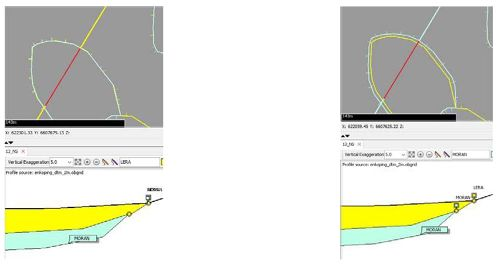
Although all cross-sections bisecting this type of issue were resolved, there still exists numerous further bedrock outcrops away from cross-sections that were not ‘fixed’. A recommendation for future work would be to resolve these.
Workflow summarised
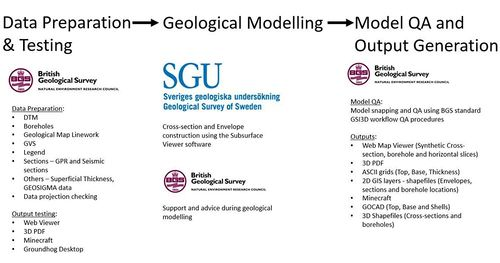
References
- ↑ Jirner, E, Johansson, P-O, McConnachie, D, Djurberg, H, McCleaf, P, Hummel, A, Ahlgren, S, Rodhe, L, and Mikko, H. Jordlagermodellering i 3D — exempel från Uppsalaåsen med hydrogeologisk tillämpning SGU-rapport 2016:19.
- ↑ Kessler, H, Mathers, S, and Sobisch, H G. 2009. The capture and dissemination of integrated 3D geospatial knowledge at the British Geological Survey using GSI3D software and methodology. Computers & Geosciences, 35(6), pp.1311–1321.